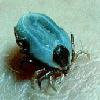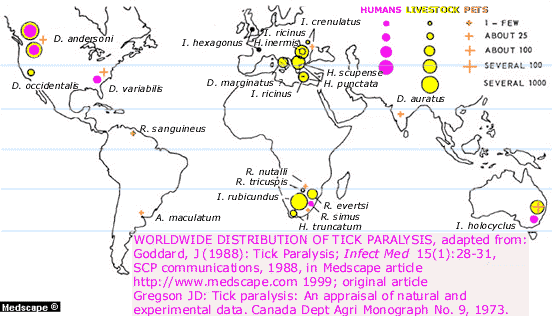WHICH TICKS of the world CAUSE PARALYSIS?
The occurrence and the nature of tick paralysis vary with the genus, species, the life cycle stage, and the gender (sex) of the tick and possibly with seasonal factors.
The nature of the paralysis can be rated according to its duration (transient to long lasting), its extent (localised to generalised paralysis) and its severity (mild paresis to paralysis and other poisonous effects).
Tick genus and species
Although tick paralysis has an almost worldwide distribution, some tick species are of special relevance in certain regions.
There are seven genera of ticks worldwide which have been associated with paralysis in animals- they are- Ixodes, Dermacentor, Amblyomma, Rhipicephalus, Haemaphysalis, Otobius and Argas. Human cases of tick paralysis have been reported from Australia, North America, Europe and South Africa and have been caused by only the first three of these, namely Ixodes, Dermacentor and Amblyomma. In all, the potential for producing paralysis has been demonstrated, described or suspected in 64 species of ticks belonging to 7 ixodid and 3 argasid genera (The Merck Veterinary Manual, 8th ed 1988). Another reference (Gothe, 1979) states that up to 43 tick species in 10 genera have been incriminated in tick paralysis in humans, other mammals, and birds (cited in Goddard, 1998). Only three or four have a venom which can be fatal (UTS, 1998). The most deadly species is concentrated in eastern Australia.
Of the Australian ticks I. holocyclus (Australian paralysis tick), I. cornuatus (the Australian Indigenous Tick) and possibly I. hirsti (the Marsupial or Cat Tick) have caused paralysis. Tick paralysis occurs in Tasmania but the species is currently being better defined- it was originally thought to be I. cornuatus but may be another species. The most severe form of paralysis of all ticks worldwide occurs with Australia's Ixodes holocyclus. Rhipicephalus sanguineus (The Brown Dog Tick), which has been associated with paralysis in dogs in the USA, may pose a similar threat in Australia.

In the USA,
infestation with Dermacentor
variabilis (the American Dog Tick), D.
occidentalis (the Pacific Coast Tick), D.
andersoni (the Rocky Mountain Wood Tick), Dermacentor
albipictus (the Winter Tick), Ixodes
scapularis (the Western Black-legged Tick, the Deer Tick)
Amblyomma americanum (The Lone Star Tick), and Amblyomma
maculatum (the Gulf Coast Tick) may result in tick paralysis.
Even Otobius
megnini (the Spinous Ear Tick) has caused paralysis. In
birds the fowl ticks Argas radiatus and A.
persicus have caused paralysis (see Cupp EW, 1991).
In North America, hundreds of cases of tick paralysis have been
documented from the Montana-British Columbia region (Gregson, 1973; Schmitt et al,
1969 ] It occurs in the southeastern US as well (Goddard, 1998)
In Africa the following tick species can cause paralysis: Ixodes rubicundus (the Karoo paralysis tick) and Rhipicephalus punctatus in South Africa, Rhipicephalus evertsi evertsi and Argas walkerae in subSaharan Africa, and Rhipicephalus evertsi mimeticus in Namibia. (The Merck Veterinary Manual, 8th edition 1988).
The following diagram showing the occurrence of tick paralysis globally is from a relatively old article (Gregson, 1973) produced by the Canadian Department of Agriculture and is probably in need of review. Interestingly Rhipicephalus sanguineus, a tick distributed wordlwide, is only recorded in this diagram as producing paralysis in South America.

Tick gender
It is generally the female tick of all species that is responsible for causing paralysis. However, the gender neutral larval and nymphal stages of Ixodes holocyclus also elaborate small amounts of the paralysing toxin (Moorhouse, 1981). Adult males might produce toxin but as they do not engorge on a host (other than perhaps the female tick) any toxin is not of medical or veterinary consequence.
Tick stage
It is generally the adult stage of tick that causes paralysis. In the case of Ixodes holocylus, large numbers of larvae (hundreds? possibly less) and nymphs (tens?, possibly less) have also been associated with tick paralysis.
Rating the paralysis
Paralysis caused by ticks can be rated according to duration,
anatomical extent and severity:
Duration:
- a transient paralysis that generally resolves when the tick is removed- e.g. the North American Dermacentor spp.
- a more prolonged paralysis which persists or even worsensafter the tick is removed- e.g. the Australian Ixodes holocyclus
Extent:
- localised to certain muscles in the vicinity of the tick. This is occasionally seen with the Australian paralysis tick. Most noticeably, eyelid paralysis occurs in dogs with ticks on the face and may result in a loss of the blink reflex and consequent irritation leading to ocular discharge and even corneal ulceration. Some other examples- a tick on the face may cause displacement of the muzzle's midline. Occasionally ther may be apparent limb weakness. A tick near the anus may cause fecal incontinence or apparent diarrhoea.
- generalised and involving the entire animal but often first noticeable as an ataxia (incoordination) and paresis (weakness) of the hind limbs in dogs, cats etc. This is the more usual presentation of paralysis caused by the Australian paralysis tick.
Severity:
- mild weakness to complete atonic paralysis of all striated/skeletal muscle tissue (which in dogs includes a major portion of the oesophagus). Recent experiments also suggest a possible direct or indirect cardiotoxicity caused by Ixodes holocyclus seen as a reduced L ventricular fractional shortening (Atwell, Campbell and Evans, 2000)
- effects other than paralysis which may actually be more life threatening. See clinical effects
- later development of tick-transmitted diseases
The Paralysis Tick of Australia - Home
E-mail Us to report a broken link!